Related Research Articles
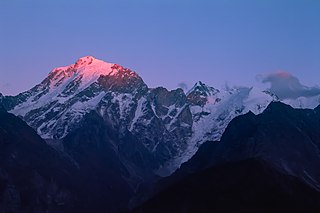
Himachal Pradesh is a state in the northern part of India. Situated in the Western Himalayas, it is one of the thirteen mountain states and is characterised by an extreme landscape featuring several peaks and extensive river systems. Himachal Pradesh is the northernmost state of India and shares borders with the union territories of Jammu and Kashmir and Ladakh to the north, and the states of Punjab to the west, Haryana to the southwest, Uttarakhand to the southeast and a very narrow border with Uttar Pradesh to the south. The state also shares an international border to the east with the Tibet Autonomous Region in China. Himachal Pradesh is also known as Dev Bhoomi or Dev Bhumi, meaning 'Land of Gods' and Veer Bhoomi which means 'Land of the Brave'.

The Beas River is a river in north India. The river rises in the Himalayas in central Himachal Pradesh, India, and flows for some 470 kilometres (290 mi) to the Sutlej River in the Indian state of Punjab. Its total length is 470 kilometres (290 mi) and its drainage basin is 20,303 square kilometres (7,839 sq mi) large.

Dharamshala is a town in the Indian state of Himachal Pradesh. It serves as the winter capital of the state and the administrative headquarters of the Kangra district since 1855. The town also hosts the Tibetan Government-in-exile. Dharamshala was a municipal council until 2015, when it was upgraded to a municipal corporation.
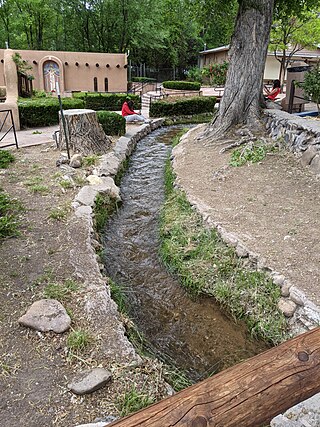
An acequia or séquia is a community-operated watercourse used in Spain and former Spanish colonies in the Americas for irrigation. Acequias are found in parts of Spain, the Andes, northern Mexico, and the modern-day American Southwest.

The Ravi River is a transboundary river crossing northwestern India and eastern Pakistan. It is one of five rivers associated with the Punjab region.

Kangra district is the most populous district of the Indian state of Himachal Pradesh. Dharamshala is the administrative headquarters of the district.
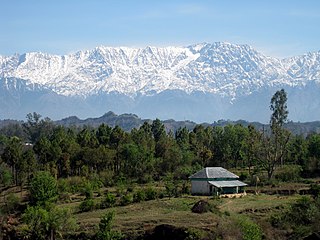
Dhauladhar is a mountain range which is part of a lesser Himalayan chain of mountains. It rises from the Shivalik hills, to the north of Kangra and Mandi. Dharamsala, the headquarters of Kangra district and the winter capital of Himachal Pradesh, lies on its southern spur in the Kangra Valley. Chamba lies to the North of this range.

Bhakra Nangal Dam is a concrete gravity dam on the Satluj River in Bhakra Village in Bilaspur district, Himachal Pradesh in northern India. The dam forms the Gobind Sagar reservoir. Nangal Dam is another dam at Nangal in Punjab downstream of Bhakra Dam. However, sometimes both the dams together are called Bhakra-Nangal Dam though they are two separate dams.
Palampur is a hill station and a municipal corporation situated in the Kangra District in the Indian state of Himachal Pradesh.

The state of Himachal Pradesh is spread over an area 55,673 km2 (21,495 sq mi) and is bordered by Jammu and Kashmir and Ladakh on the north, Punjab on the southwest, Haryana on the south, Uttarakhand on the southeast, a small border with Uttar Pradesh in the south, and Tibet on the east. Entire Himachal Pradesh lies in the mountainous Himalaya region, rich in natural resources

Maharana Pratap Sagar, also known as Pong Reservoir or Pong Dam Lake is a large reservoir in Fatehpur, Jawali and Dehra tehsil of Kangra district of the state of Himachal Pradesh in India. It was created in 1975, by building the highest earthfill dam in India on the Beas River in the wetland zone of the Siwalik Hills. Named in the honour of Maharana Pratap (1540–1597), the reservoir or the lake is a well-known wildlife sanctuary and one of the 49 international wetland sites declared in India by the Ramsar Convention. The reservoir covers an area of 24,529 hectares, and the wetlands portion is 15,662 hectares.

The Indian state Himachal Pradesh has a large number hydroelectricity resources, about twenty five percent of the national potential. About 27,436 MW of hydroelectric power can be generated in the state by the construction of various hydroelectric projects on the five perennial river basins. Out of total hydroelectric potential of the state, 10,519 MW is harnessed so far, out of which 7.6% is under the control of Himachal Pradesh Government while the rest is exploited by the Central Government. The state government has been giving the highest priority for its development, since hydroelectric generation can meet the growing need of power for industry, agriculture and rural electrification. It is also the biggest source of income to the state as it provides electricity to other states.

Kangra Valley is a river valley situated in the Western Himalayas. It lies in the state of Himachal Pradesh in India, and is a popular tourist destination. The Kangri language is spoken there. Dharamshala, the headquarters of Kangra district and the main city of the valley, lies on the southern spur of Dhauladhar.

Lift irrigation is a method of irrigation in which water is not transported by natural flow, but is lifted with pumps or surge pools etc.
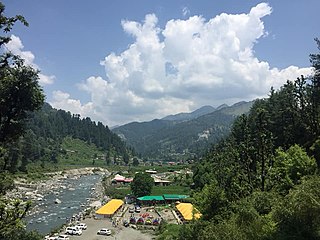
Barot, a village originally developed in the 1920s for Shanan Hydel Project, is now a tourist location in Mandi district in the Indian state of Himachal Pradesh. Barot was difficult to access until 1975, when a road was opened. It is situated 40 km from Jogindernagar and 65 km from Mandi, the district headquarter. The road to Barot branches off at Jogindernagar-Mandi Highway and from Jogindernagar the distance is 40 km. It is sometimes possible to use the funicular trolley from Jogindernagar which reduces the distance to 12 km. The road route includes terraced fields and thick cedar forests, rising to Jhatingri at the hilltop. The remains of the summer palace of the former rulers of Mandi are located here. Through the small village of Tikkan, the road carries on to Barot. The town has a range of outdoor activities, including a trout breeding centre, from where fish are released into the Uhl river. A 30 km section of the river is used for angling.

The Kangra Valley Railway is a 2 ft 6 in gauge railway that runs from Pathankot, Punjab to Jogindernagar in Himachal Pradesh. It runs through the sub-Himalayan region of Kangra Valley and is 164 km (101.9 mi) long. It is on the UNESCO World Heritage Sites tentative list. The railway is part of the Firozpur division of Northern Railway. It is the longest Narrow Gauge line in India and also the longest 2 ft 6 in Gauge Railway in the World. The highest point on this line is Ahju station at an elevation of 1,290 meters (4,230 ft). There are 33 stops and 950 bridges.
Kotla is a small hill town situated on the Pathankot–Dharamshala road, in Himachal Pradesh, India. It is located in the Kangra district. The town is about 45 kilometres (28 mi) from Pathankot and the same distance from Dharamshala. Its geographical coordinates are 32° 15' 0" North, 76° 2' 0" East.
Irrigation is the artificial exploitation and distribution of water at project level aiming at application of water at field level to agricultural crops in dry areas or in periods of scarce rainfall to assure or improve crop production.
This article discusses organizational forms and means of management of irrigation water at project (system) level.

The Uhl is a Himalayan river which is part of the watershed of Beas river. The river originates at the Thamsar Glacier in the Dhauladhar range of the Himalayas, flows through the Uhl valley crossing the villages Bada Gran (Baragram) and Barot. In its lower course, it is also known as Tiun Nala and the Uhl valley is known as Chohar valley. After passing the Chohar valley, the Uhl meets the Beas river 5 km downstream from Pandoh.
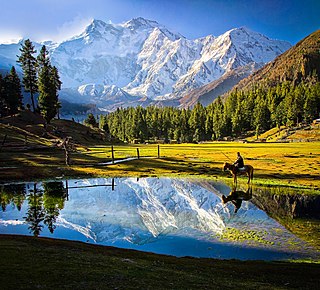
The Western Himalayas refers to the western half of the Himalayas, in northwestern India and northern Pakistan. Four of the five tributaries of the Indus River in Punjab rise in the Western Himalayas; while the fifth, the Sutlej cuts through the range after rising in Tibet.
References
- ↑ "Digital Library Of The Commons". dlc.dlib.indiana.edu. Retrieved 2020-07-27.
- 1 2 3 Baker, J Mark (2005). The Kuhls of Kangra: community-managed irrigation in the western Himalaya. The University of Washington Press.
- 1 2 "Irrigation in Kangra valley: no longer kuhl". People's Archive of Rural India. 2019-05-13. Retrieved 2020-07-27.
- ↑ "HimalDoc". lib.icimod.org. Retrieved 2020-07-27.
- ↑ "Kuhl, kohli and a lost tradition". www.indiawaterportal.org. Retrieved 2020-07-27.
- ↑ "Small projects, big impacts: Micro and mini hydel projects of Himachal Pradesh". www.indiawaterportal.org. Retrieved 2020-07-27.
- ↑ Sandrp (2014-10-04). "Hydropower in Himachal: Do we even know the costs?". SANDRP. Retrieved 2020-07-27.
- ↑ "HP 'Kulhs' bear the brunt of small hydro projects". The Statesman. 2018-05-07. Retrieved 2020-07-27.
- ↑ "Amit Tandon | Connecting Social and Physical Boundaries of the Commons : Case study : Kuhl Irrigation Systems of Kangra. Rural. - ppt télécharger". slideplayer.fr. Retrieved 2020-07-27.
- ↑ Ostrom, Elinor (23 September 2015). Governing the commons : the evolution of institutions for collective action. ISBN 978-1-107-56978-2. OCLC 1096208988.
- ↑ Mosse, David (1997). "The Symbolic Making of a Common Property Resource: History, Ecology and Locality in a Tank-irrigated Landscape in South India". Development and Change. 28 (3): 467–504. doi:10.1111/1467-7660.00051. ISSN 1467-7660.
- ↑ De Angelis, M. (2010). The beginning of history : value struggles and global capital. Pluto. ISBN 978-1-78371-657-9. OCLC 1030391313.